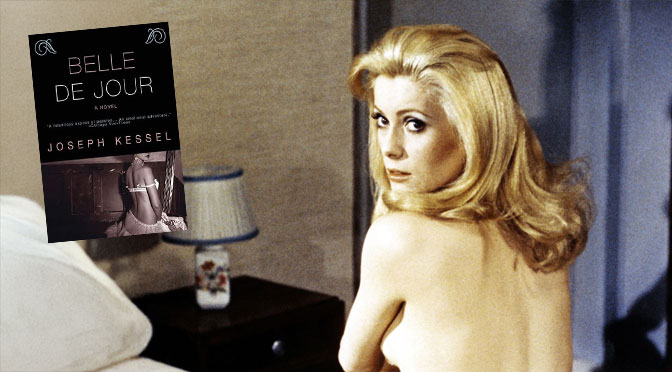“Belle de jour” tells the story of Séverine Serizy, a young, attractive woman from the Parisian bourgeoisie who is emotionally and sexually unfulfilled in her marriage to the wealthy but unemotional doctor Pierre Serizy. Despite her love for Pierre, Séverine longs for experiences that fulfill her secret and unspoken fantasies. When she hears about an exclusive brothel in Paris through an acquaintance, she decides to give in to her hidden desires and begins working as a prostitute under the name ‘Belle de jour’ (Daytime Beauty). Her meetings at the brothel take place during the day, while her marriage and bourgeois existence remain intact.
The novel explores Séverine’s double life – the differences between her chaste and virtuous existence as a wife and her secret adventures, which fulfill her deepest erotic fantasies. At the brothel, Séverine experiences humiliation, lust and power – everything her married life cannot offer her. But this dangerous balancing act between bourgeois facade and sexual freedom leads to conflicts and dangers when Séverine’s secret life gradually threatens to be exposed.
Why is “Belle de Jour” a masterpiece of erotic literature?
- Exploration of female sexuality and repression: Kessel’s novel is remarkable for its focus on the inner world of a woman constrained by the strict morals of her time, both in her marriage and in society. Séverine’s sexual repression and double life in the brothel reflect the contradictions and constraints faced by women who want to explore their sexuality outside of societal norms.
- Psychological depth: Kessel gives readers insight into the psychological complexity of his protagonist. Séverine’s actions are not simply motivated by lust, but by a deeper yearning for self-fulfillment and power over her own desires, which she cannot live out elsewhere.
- Eroticism and Subversion: Belle de jour subverts traditional notions of female sexuality and marriage. It is the tension between bourgeois decorum and wild, untamed desire that Kessel masterfully depicts. Erotic scenes are not merely physical, but permeate Séverine’s inner life – they are reflections of her fears, hopes and inner conflicts.
- Subtle poetry of language: Kessel writes in a language that is both direct and elegant. He avoids excessive vulgarity, instead relying on stylish descriptions that make the erotic sensual but not explicit. The art lies in the innuendo and unspoken desires that permeate the novel.
Is it still worth reading today?
Even in a much more libertarian time, Belle de jour is relevant because it is not just about sexual liberation, but about the psychological and emotional conflicts that often go hand in hand with this freedom. In modern discussions about female autonomy and self-determination in sexuality, Kessel’s work shows that such issues are universal and timeless. The tension between social expectations and personal fulfillment remains relevant today.
Although we talk more openly about sexual issues today, the question of the inner world of desire – and how it relates to external constraints – remains an eternal challenge. In this respect, reading Belle de jour is still fascinating and instructive.
The novel’s genesis and reception history
Joseph Kessel, a journalist and writer, wrote Belle de jour in 1928 during a period of social upheaval in France. The 1920s, also known as “les années folles”, were characterized by a loosening of moral norms and an opening up to new artistic and literary forms of expression, particularly in the area of sexuality. Kessel’s novel was perfectly suited to this period, in which the concept of marriage, morality and femininity was being questioned.
The novel attracted a great deal of attention, but was also controversial, as it focused on the topic of female sexuality and the double standards of bourgeois society. Nevertheless, the novel was soon recognized as a work of great literary depth. It was definitively recognized as a classic of French literature and erotic cinema with the iconic 1967 film adaptation by Luis Buñuel, starring Catherine Deneuve as Séverine.
What can contemporary erotic writers learn from the novel?
- The power of suggestion: Kessel shows that eroticism doesn’t have to be explicit or vulgar to be profound. The psychological and emotional nuances of the characters are just as important as the physical acts themselves. Contemporary writers can learn from Kessel’s ability to create erotic tension through suggestion, silence, and interior monologue.
- Exploring inner conflict: Modern erotic literature can learn a lot from the psychological depth that Kessel gives to his protagonist. Eroticism is not just a physical experience, but is often linked to questions of identity, power and self-discovery. Exploring these dimensions can increase the emotional resonance of a work.
- Social reflection: Erotic literature can still challenge social norms and morals today. Kessel’s courageous confrontation can inspire authors with the double standard of sexuality and society’s unspoken desires.
In conclusion, Belle de jour remains relevant today because it explores the deeper psychological and societal implications of sexuality. It is a work that goes far beyond the mere recounting of erotic experiences, forcing the reader to reflect on the nature of desire, identity, and freedom.

